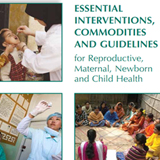
A new global consensus has been agreed on the key evidence-based interventions that will sharply reduce the 358 000 women who still die each year during pregnancy and childbirth and the 7.6 million children who die before the age of 5, according to a massive, three-year global study. The study, Essential interventions, commodities and guidelines for reproductive, maternal, newborn and child health, is designed to facilitate decision-making in low- and middle-income countries about how to allocate limited resources for maximum impact on the health of women and children.
The study reviewed more than 50 000 scientific papers to determine the proven effectiveness of interventions and impact on survival, identifying 56 essential interventions that when implemented in "packages" relevant to local settings, are most likely to save lives.
This document is designed for an audience of policy-makers who seek information on the specific health interventions to address the main causes of maternal, newborn and child deaths.
It is the result of collaborative work among many partners. The process was led by the World Health Organization, Switzerland, and the Aga Khan University, Pakistan. Experts in maternal, newborn and child health participated in meetings in Geneva in April 2010 and September 2011 and provided inputs to the development and finalization of this document. The contributions of the World Health Organization, the Aga Khan University, invited experts and partners are gratefully acknowledged.
This publication, and related advocacy material, will be distributed to over 430 PMNCH partners, and other stakeholders, primarily via the PMNCH website and knowledge portal. In addition, it will be distributed, and discussed, at selected RMNCH advocacy events.
2 comments